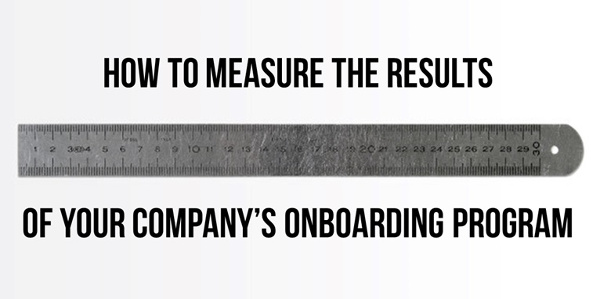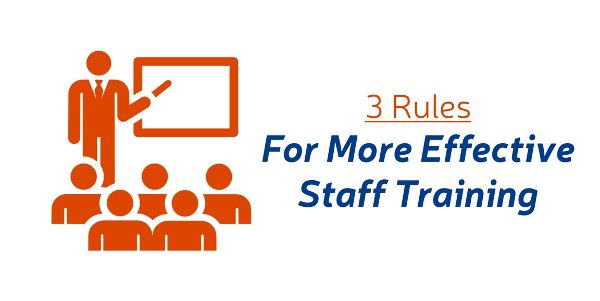How to Measure the Results of Your Company’s Onboarding Program
Posted January 11th, 2017 by myngleCategories: HR topics and support

Many of the employees who leave do so within the first year. If we want to impact first year turnover, it’s important to examine the processes, programs, and activities that are a part of the new hire experience. Probably, the biggest being onboarding.
According to Wikipedia, onboarding is defined as the socialization process where employees acquire the knowledge, skills and behaviors to become effective inside the organization. Using this definition, onboarding includes administrative processing, training, development, and productivity.
So, it’s important to understand the components and goals of your onboarding program so you measure the right outcomes. Let’s use this definition to discuss several options for measuring the results of your onboarding program.
Make the onboarding process more cost-effective
Orientation is a specific process within onboarding and, as such, we can calculate a specific cost. Orientation programs traditionally contain administration and training that applies to every employee like ethics, civility, and general organizational communications.
A common metric is orientation cost per employee. In the book “How to Measure Human Resource Management” by Dr. Jac Fitz-enz, the calculation is presented as:
OC/E = [(T x (R/h x E)) + DC] / E
OC/E Average cost to orient an employee
T Time spent in orientation
R/h Average hourly rate of attending employees
DC HR department cost per employee
E Total number of employees oriented
It is possible that organizations are unable or unwilling to reduce the investment made in employee onboarding. And that’s completely understandable. Another way to evaluate cost-effectiveness of orientation is by monitoring the cost for staff to conduct the program.
So you might not be able to change the cost per employee, but you can change the cost to deliver the program. Fitz-enz also identifies the calculation for HR department orientation expense in the same book:
HROE = (T x R/h) / E
HROE HR department orientation expense
T Time spent by HR in orientation
R/h Average hourly rate of HR staff, including benefits
E Total number of employees oriented
Understanding the costs associated with orientation can help HR departments evaluate onboarding technology solutions. It can also provide guidance on logistical decisions like the length of orientation and what topics should be covered.
Improve the impact and value of the program
It can be tempting to focus completely on cost-related metrics to evaluate onboarding. While numbers are important, sometimes the value of a program is more qualitative.
Employees can provide significant feedback and insights that will improve the process. For example, asking new hires to complete a Kirkpatrick Level 1 evaluation (Reaction) can provide an initial read that helps HR to understand the level of enthusiasm that new hires have immediately following milestones in the process.
Organizations can conduct new hire surveys at regular intervals to allow organizations to take a pulse on the program. Employees can rate statements about the following topics:
- Perceptions about feeling welcomed as a new employee (i.e. “I felt welcomed on my first day.”, “My manager greeted me on my first day of employment.”, “My co-workers made me feel a part of the team.”)
- Value and timing of information received (i.e. “I immediately used the information I received during orientation.”, “What information would have been helpful to receive during orientation that you did not receive?”, or “What information did you receive during orientation that could have been provided later?”)
- Alignment between pre-hire conversations and post-hire realities (i.e. “Is there anything you learned after hire that would have been helpful to know prior to accepting the offer?”, “Is there anything we told you during the recruiting process that was incorrect?”, or “Now that you’ve been doing the job for a few weeks, is the job what you thought it would be?”)
- New hire training (i.e. “Do you feel you’ve been adequately trained for your position?”, “Do you know what it takes to get promoted in the company?”, and “Is there something you expected to receive training on that you have not?”)
Include indirect outcomes
While there are ways to measure the results of your onboarding program, it’s possible that HR doesn’t have the resources. This doesn’t mean that it’s impossible to gauge program results. Even if you don’t measure the onboarding process, onboarding results impact other HR metrics. Ultimately, an effective onboarding program should:
- Increased employee engagement which can be measured through employee surveys and productivity scores. Surveys can have benchmark questions, which remain constant year over year that allow for a comparison of scores.
- Improved products and services measured with quality and customer service scores. Quality programs such as LEAN and Six Sigma can provide a quantitative process to monitor outcomes and a highly defined process for repairing flaws.
- Reduced turnover, so turnover rate and cost of turnover are relevant measures. Monthly turnover rate is calculated by taking the number of separations during a month divided by the average number of employees on the payroll (multiplied by 100.)
There are many cost of turnover calculators available via the internet. In the article “How to Really Calculate the Cost of Employee Turnover”, Dr. Greg Willard includes pre-departure and vacancy costs.
Align your onboarding evaluation process with program goals
The key to successfully evaluating your onboarding program is having a clear understanding of the program’s goals. This allows you to collect the right information.
Before starting any type of metrics dashboard, take the time to get senior management buy-in for reporting. Just like you want to align metrics with program goals for maximum impact, you want to align the dashboard with those metrics that senior leadership wants to see. No sense in spending valuable resources collecting data and reporting it if no one wants to read or make decisions using the information.
Measure what you can control. Find out which metrics the organization wants to see, what report format will be the most appealing, and how often to distribute the report. Once senior management is accustomed to the information. They will ask for more. Trust me.
Metrics and information are an important piece of the employee experience. They can prove trend data that helps us keep programs fresh and employees engaged. Gathering the information and data doesn’t have to be difficult. It does need to be focused on measuring the right things.
About the author:
 Sharlyn Lauby is an author, writer, speaker and consultant. She has been named a Top HR Digital Influencer and is best-known for her work on HR Bartender, a friendly place to talk about workplace issues. HR Bartender has been recognized as one of the Top 5 Blogs read by HR professionals by the Society for Human Resource Management (SHRM.)
Sharlyn Lauby is an author, writer, speaker and consultant. She has been named a Top HR Digital Influencer and is best-known for her work on HR Bartender, a friendly place to talk about workplace issues. HR Bartender has been recognized as one of the Top 5 Blogs read by HR professionals by the Society for Human Resource Management (SHRM.)
Sharlyn is the author of “Manager Onboarding: 5 Steps for Setting New Leaders Up For Success”and “Essential Meeting Blueprints for Managers,” both are available at the SHRM Store.

 Suzanne Lucas spent 10 years in corporate human resources, where she hired, fired, managed the numbers, and double-checked with the lawyers. Now she writes about how to managers can manage their employees and employees can manage their managers, along with tips for making your career great. You can reach her at
Suzanne Lucas spent 10 years in corporate human resources, where she hired, fired, managed the numbers, and double-checked with the lawyers. Now she writes about how to managers can manage their employees and employees can manage their managers, along with tips for making your career great. You can reach her at 
 Quynh Nguyen writes about productivity for individuals and teams while travelling the world. She loves learning languages, riding a bike and having many nice cups of tea. Connect with her
Quynh Nguyen writes about productivity for individuals and teams while travelling the world. She loves learning languages, riding a bike and having many nice cups of tea. Connect with her 

 The future of work is virtual, according to a survey published in Fast Company. Thirty-four percent (34%) of business leaders said that
The future of work is virtual, according to a survey published in Fast Company. Thirty-four percent (34%) of business leaders said that  Think about your ideal job. Does it involve getting to work at the crack of dawn, barely having time to grab lunch, and getting home after dark—even in the summer? Of course not. The ideal job allows time for family and friends, as well as a good pay check and a challenging work environment.
Think about your ideal job. Does it involve getting to work at the crack of dawn, barely having time to grab lunch, and getting home after dark—even in the summer? Of course not. The ideal job allows time for family and friends, as well as a good pay check and a challenging work environment.
